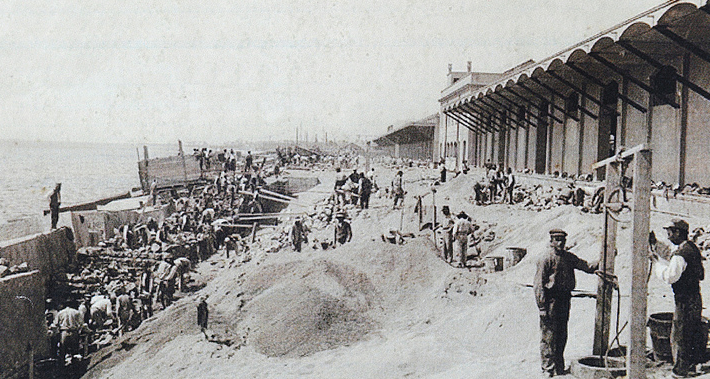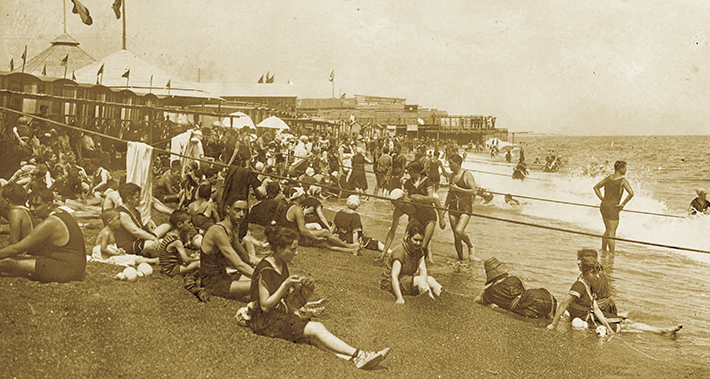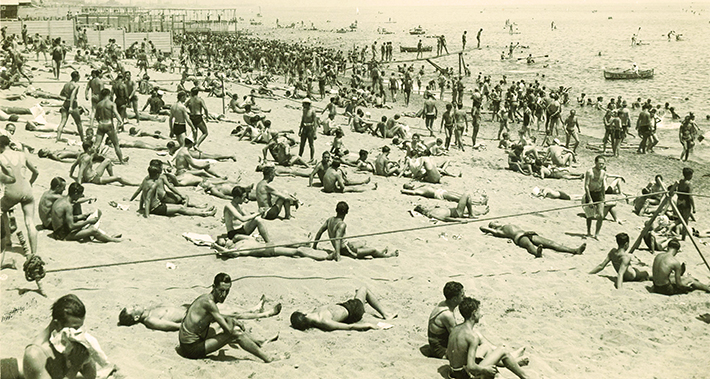History of the beaches



During the last few years, the beaches of Barcelona, and their special features which make them so attractive, have become one of the most popular public areas of the city. Beaches constitute a large open air area where we can come into contact with the sea, the sun and the sand, and where we can also become familiar with marine fauna. All of this is possible on the beaches in Barcelona which are close to home and which can be enjoyed all year round.
There are all kinds of leisure activities which take place around the beaches, which makes them an ideal area to enjoy the company of others. However, Barcelona's relationship with the sea has changed throughout history.
The sea has played an important role in making Barcelona an open city, in which peoples and cultures have mixed since ancient times. The medieval and modern city established trade relations by sea but, with the passing of time, we have witnessed a growing need to have more contact with the sea, beyond merely mercantile and fishing activities.
Over the years, the inhabitants of Barcelona have become more attracted to sea bathing, swimming courses and sailing competitions. The reconstruction of the Maritime Front of the city, begun in the 1980's, meant a historical change and has contributed to making the beaches part of our daily life.
Barcelona and the sea
Since its beginnings, the history of Barcelona has been closely linked to the sea. Over the centuries, the coastline has varied as a result of the constant dynamics between the sea and the land. In the fifth century, the Montjuïc mountain and its Iberian settlements presided over the plain situated around the Marina mountains, lying between the Rubricatus (Llobregat) and Betulònica (Besòs) rivers, which at the time had a completely different coastline to that of today. To the west of Montjuïc there were long beaches, and between the mountain and the hill later called Taber (today Carrer Paradís and its surroundings), a small bay allowed the sea to flow inland much further than the costal strip of today. Facing the sea, on the top of this hill, the Roman Barcino was established.
Later, the sea receded, creating islets and lagoons. The sea continued to recede and the new areas of land which began to appear were occupied by farming land and houses. Since then and to the present day, the history of Barcelona has been a permanent courtship between the sea and the land; a relationship that has permitted a constant melting pot of peoples and cultures which has given the city its undisputable cosmopolitan and Mediterranean condition.
Today, the Barcelona coastline is a built-up landscape, the inheritance of centuries of evolution. It is a people's landscape which stands out for its beaches, which now form part of the history of the city. The beaches are easily accessible and integrated into the city just like any of its other public areas. However, as well as providing an opportunity to enjoy leisure and sports activities, the beaches also make it possible to move from an urban world to the natural world of the sea, so rich but perhaps not as well known as it should be.
Our beaches today
The urban remodelling, resulting from the Olympic Games in 1992, underlined three main decisions: the cleaning up and consolidation of the coastline, the removing of the coastal railway lines and the construction of the Ronda (Ring Road) and Parc del Litoral.
In the fourth century B.C., the plain was inhabited by the Laietans, Iberian tribes which populated the areas of Barcelonès, Maresme and Vallès. Archaeological findings seem to indicate that the Laitans from Barcelona (the Iberian Laie) used a small cove on the west of Montjuïc as a natural port, and, enriched by the contribution from other Mediterranean cultures, (Phoenicians, Greeks, Etruscans, etc.) who were more advanced in commerce and the art of sailing, they carried out some kind of commercial exchanges by sea, probably with Empúries (the Greek Empòrion).
In the year 218 B.C. the Romans embarked on the conquest of the Iberian Peninsula and, although they were not expert sailors, the fusion of the Iberian people with the Roman Barcino laid down the origins of what, centuries later, would be one of the most important enclaves for Mediterranean Sea commerce. Battleships, two oared or three oared ships, light and long, ships which were shorter in length but wider of berth, many loaded with wine caskets, and small shipping vessels which followed the coastline, frequented the waters of the ancient Roman Barcelona. This is how prosperity began for a city which would always be a sea port.
In the second century, Barcelona had a population of between 3,500 and 5,000 inhabitants. Over one thousand years later, in the 13th century, the population was of some 40,000 people, a considerable size for a city at that time. Barcelona began to take on its role as a capital city during the sixth and seventh centuries, at the time of the Visigoths. This status became definitive in 1253 when Jaume I awarded the city's 'Council of One Hundred' the privilege of designating the "Cònsols d'Ultramar" (Sea Judges), who were to represent the interests of the Kingdom of Aragon and Catalonia.
In the 13th century, after overcoming long periods of crisis and decadence, Barcelona was established as a great city and an important Mediterranean capital which stood out for its cosmopolitan and entrepreneurial character. One of the economic activities which best describes this was sea commerce. Ships from Maghreb arrived at Barcelona loaded with wool, furs, leather and also products from Saharan lands. Wheat, cotton and corral were imported from Sicily; figs, cheeses and salt fish from Sardinia. Spices such as pepper, ginger, incense and cinnamon arrived from the East. Ships set sail from Barcelona carrying manufactured products, woollen fabrics, glassware, lead, copper, rice and wine. It was a time of intense activity which was concentrated on an area of beach which stretched between Puig de les Falsies (today's Plaça Palau) and the l'Arenal de Santa Clara (Parc de la Ciutadella).
On the beach itself, there was an incessant movement of people who were occupied in a great variety of jobs among which were merchants, trades people, ship owners, boatmen, sailors, rope makers, ship makers, carpenters and crossbowmen. One of these professions was that carried out by common workers or riverside servants, who had their own guild, and who were in charge of organizing and sorting the merchandise.
Another job related to the loading and unloading of merchandise was that carried out by the port transporters, who were better situated than other workers as they had their own mules for transporting merchandise. In this way, the beach of medieval Barcelona became an enormously important place for a city which had made commerce its main economic activity.
The coastline was quite different to what it is now. The sea at Barcelona reached up to what is today the Santa Maria del Mar church. Outside the walls of the city and surrounding the water, there was a humble neighbourhood of huts and shacks called Vilanova del Mar, inhabited by fishermen and other sea tradesmen of the time.
On the beaches of Barcelona during the middle ages, it was also possible to find pirates, corsairs and crossbowmen (men skilled in archery) among the port workers. One of the most serious problems for the ships leaving or arriving on the beaches of Barcelona was safety, due to the abundance of pirates and corsairs. In the 13th century, Barcelona competed commercially with other cities such as Pisa, Venice and Genoa. This competition often prompted ships from other cities to attack and board each other at high sea to capture the foreign merchandise.
When these activities took place with the blessing of the king or the local authorities, those that carried out the attacks were called corsairs and were even considered to be heroes. Those that acted "illegally", those that acted on their own without distinguishing between the origins of the boarded ships, were considered to be pirates and therefore, outlaws. Piracy was common around the Mediterranean at that time so, for this reason, crossbowmen travelled on merchant ships.
During the eighth century, the walled city from the Roman times was surrounded by new walls. The area of the beach, however, was free from fortifications. Between the 13th and 14th centuries, the population of the area between the city and the sea continued to increase. The Regomir, the city's first sea neighbourhood, built on the sea side of the entrance of the old Episcopal castle, standing next to the Roman wall of the city, continued to grow.
Between 1427 and 1475, the sea wall was built which stretched from what is today Plaça Antonio López to Drassanes. Later the wall which continued from here to Hortes de Sant Bertran was also built, and finally, the wall between Torre Nova and the monastery of Santa Clara was built. During the period of construction of the first of these stretches of wall, the first attempt was made to construct an artificial port in the city Barcelona. This and other projects that followed would change the sea façade of the city and as the large port became more consolidated it absorbed a large part of the activity which characterized the beaches of medieval Barcelona.
With regards to coastal dynamics, the building of the dike after construction work was renewed in 1590 meant the acceleration of the natural growth of the beaches of Barcelona. According to Joan Alemany in his book "El Port de Barcelona", it has been calculated that since the beginning of construction work in 1447 "the beach receded towards the sea some 500 metres until 1697 and between 800 and 900 metres until its position today". It is here, on the land originally covered by sea, where in the 18th century the district of Barceloneta was created.
Urban reforms, the inauguration of the railway line between Barcelona and Mataró (1848), and the demographic and industrial growth of the city had a decisive influence on the new design of the Barcelona coastline. Between 1878 and 1881 the sea wall built in the 16th century was demolished, which gave way for the construction of Passeig de Colom. At the foot of these walls, facing the sea, there were the popular "pudes", small taverns so named probably from the bad smell that characterized an area which stood next to some foul and stagnant water deposits.
In the 18th century, industrialization, fundamentally in the textile sector, began in Barcelona. As from the second half of the 19th century, this development received a strong and renovating boost. The availability of water and the city's condition as a port, among other strictly economic and social reasons, facilitated industrial development and diversification, with a large part of the industry concentrated near to the port.
Thus, a costal landscape with a clear dominance of great industrial installations was built. During the course of the 19th century and the first half of the 20th century, between the railway line and the sea, an isolated area was created which soon reached levels of extreme degradation. Later, industrial activity in the area began to decrease until the majority of the large installations were abandoned and the coastal strip of the districts of Poble Nou and St. Martí de Provençals became an uncontrolled tip, and large quantities of urban and industrial waste waters were poured into the sea.
As a result of the environmental deterioration of the Barcelona coastline, especially from the second half of the 19th century and well into the second half of the 20th century, it was often remarked that the city lived with its back to the sea. This statement however, is probably not true. Barcelona never surrendered its status as a coastal city. The numerous initiatives from the end of the 19th century to the beginning of the 20th century to claim the coastline back as a public area for sport, leisure or cultural activities, the maintenance of its fishing activity, the unquestionable and intense relationship of the city with its port, and the perseverance of an area with its own personality and sea traditions such as is Barceloneta, demonstrate that, in some way, the city, although having witnessed the degradation of its coastline, never broke off its historical relationship with the sea and its beaches.
The opening of several bathing establishments on the beaches of Barcelona during the second half of the 20th century reflects the growing demand for this type of installations. Some of these establishments disappeared over the years, but others remained open until well into the 20th century. Among the most well-known, all of which were situated on the beaches of Barceloneta, it is worth mentioning "els banys de La Senyora Tona" or those at Salé, "Astillero","Sant Miquel" (originally situated at Can Tunis), "La Deliciosa", "Junta de Damas", "Neptuno", "La Sirena" and "El Tritón". Also in Barceloneta, the "San Sebastián" baths were the first, and not without causing a scandal, to install a bathing area on the beach which allowed mixed bathing.
In 1912, to the east, near to the district of Bogatell, the Mar Bella sea baths were inaugurated, which remained open until the 1940's when they were destroyed by a storm. At the time it was considered to be the cleanest area of the beaches in Barcelona. On the Marina, on the Beaches of Can Tunis, the "Espanya", "Cibeles" and especially the "Baños Zoraya" baths popularly known as "El Balneari" were also well-known.
Bathing in open sea in Barcelona at the time was quite an adventure. Getting to the beaches was time consuming. Until tram lines were installed, such as those which connected some of the baths at Barceloneta with Ronda Sant Antoni, Sants or Plaça de Catalunya, people walked to the beach.
The bathing establishments permitted swimmers to combine sea bathing with what was then called "banys de pila" (baths and swimming pools). Some establishments offered complementary services such as gymnasiums and solariums. An event which caused great excitement in the city was the 1872 inauguration of the "Oriental" baths, a luxurious Arabian style construction which offered facilities unknown until then.
During the first two decades of the 20th century, four companies were founded which became pioneers in Spain in the sports of rowing, sailing and swimming. In 1902, as a result of the joining of the Real Club de Regatas de Barcelona (1881) and the Real Yacht Club (1879), the Real Club de Barcelona was founded, which is the present day Reial Club Marítim de Barcelona. In 1909, due to internal disputes, principally resulting from an eternal rivalry between those who practiced rowing and those who practiced sailing, there was a division of the company which resulted in the birth of a new club: the Club Náutico de Barcelona.
During their first years of existence, the offices of both companies were installed in two nearby floating buildings, moored at Portal de la Pau. Two other historical companies related to the sea and the beaches of Barcelona were also founded during the first years of the 20th century: the Club Natació Barcelona and the Club Natació Barceloneta.
The new pedagogical approach, which at the beginning of the 20th century revolutionized the school model in force until that time in the city, also recognized the importance of living in harmony with nature and of making the practice of physical education and sport part of the school curriculum. Also, at this time, the sea and the beaches of Barcelona were witnesses to a singular experience, in this case coming from a municipal initiative. In 1922, in Barceloneta at the end of Carrer Almirall Aixada, next to the Oriental baths, and on the same beach, the Sea School was inaugurated.
The basic objective of the Sea School was to provide a home for children, who were not ill, but who showed some signs of physical weakness and who were advised to live a more healthy life, away from the polluted environment of the city. The building was destroyed by bombs in 1938 in the middle of the Civil War. After this, the building was transferred to Montjuïc and finally, in 1948, to the district of Guinardó.
The urban remodelling, resulting from the Olympic Games in 1992, underlined three main decisions: the cleaning up and consolidation of the coastline, the removing of the coastal railway lines and the construction of the Ronda (Ring Road) and Parc del Litoral.
From the construction of the Vila Olímpica - the first great emblematic work of the 'Barcelona 1992' project - to the recent constructions carried out for the Fòrum, a new sea front has been designed consisting of various areas with different characteristics depending on surface, purpose and planned use, and with a specific urban structure in accordance with the demands of the surroundings. All of these, however, have been designed according to the same criteria: to closely relate the eastern coastline, its sea and its beaches with the nearby districts and to integrate it into the city as one more of its public areas, in the most rational and sustainable way possible.
